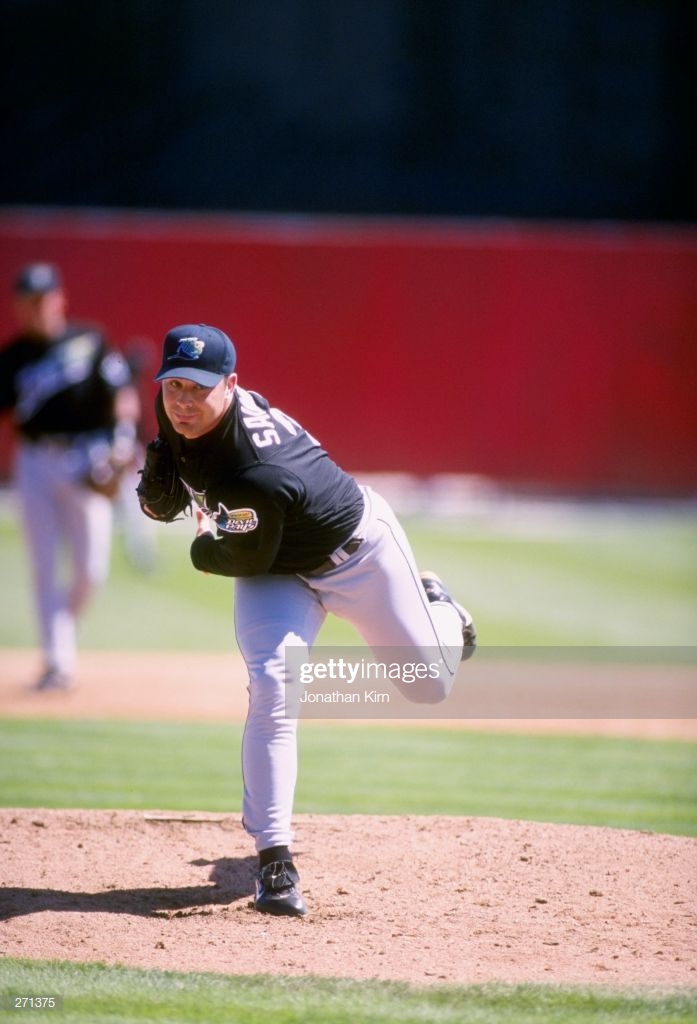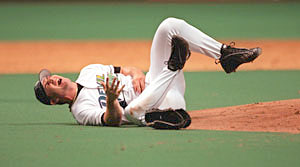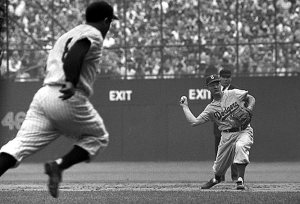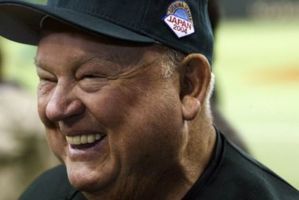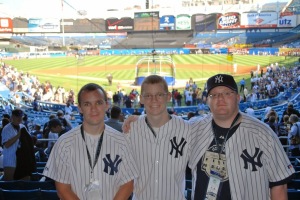Tagged: Devil Rays
Reaching Your Goal
Are you part of the nearly half of New Year’s Resolutioners that have given up? Or are you one of the less than 10% who will be successful? Life is hard, keep working towards your dreams. Ron Wright never gave up. He fought for what he wanted. All of his hard work eventually paid off.
Ron Wright was selected in the 7th Round of the 1994 MLB Draft by the Atlanta Braves from Kamiakin High School in Kennewick, Washington. He played two and a half seasons in the Braves minor league system. Wright spent 1994 with the Rookie Level Gulf Coast League Braves, 1995 with the Single A Macon Braves, and 1996 with the High A Durham Bulls and Double A Greenville Braves before an August trade to the Pittsburgh Pirates. Wright now set his sights on the Steel City. He finished 1996 with the Double A Carolina Mudcats and spent 1997 with the Triple A Calgary Cannons. 1998 was a lost season as Wright appeared in only 20 Games, 17 with the Triple A Nashville Sounds and 3 with the Rookie Level Gulf Coast League Pirates. 1999 was equally frustrating, playing only 24 Games for the Double A Altoona Curve. In October, the Cincinnati Reds selected Wright off waivers. His aim moved further down the Ohio River. Wright spent 2000 with the Double A Chattanooga Lookouts and Triple A Louisville RiverBats. In November, Wright signed as a Minor League free agent with the Tampa Bay Devil Rays. He spent the season back with the Durham Bulls, now a Triple A team. Again a Minor League free agent, Wright signed with the Seattle Mariners for the 2002 season. He began the season with the Triple A Tacoma Rainiers. Ron Wright had played eight Minor League seasons with 12 different teams.
Heading into the 2002 season Wright had played in 666 Minor League games. He hit .261 with 121 Home Runs, 453 RBI, and 361 Runs scored in 2,729 Plate Appearances. Wright had played at every level, Rookie Ball to Triple A. He fought through injuries and the ups and downs of professional baseball. Wright remained one step away from the Majors. The trip from Cheney Stadium to Safeco Field is only 35 miles, but Wright kept fighting to make that drive.
The bad news in Seattle was future Hall of Fame Edgar Martinez was hurt running to First. Martinez’s injury put a damper on the Mariners early season success. Edgar’s injury was bad news for everyone except Minor League journeyman Ron Wright. He finally got the call to the Big Leagues. The years of toil had paid off. He was heading to the show.
It was a pleasant afternoon in Arlington, Texas. It was 76℉ and overcast. Ron Wright had made it to the Majors on Sunday, April 14, 2002. The Mariners were on the road, playing the Rangers at The Ballpark in Arlington. 32,866 fans watched as Seattle’s John Halama faced off against Texas’ Kenny Rogers. Ron Wright was the DH, batting 7th for the Mariners. All was right in the world.
In the Top of the 2nd, Ron Wright strolled to the plate. This was the moment he had worked so hard for, his first Major League At Bat. Ruben Sierra was standing on Second after a lead off Single and a John Olerud Walk. Wright stepped in the Right Handed Batters Box looking to add to the Mariners 1-0 lead. Kenny Rogers rocked and fired. In the blink of an eye, Wright was walking back to the dugout. Striking out looking on three pitches was not how Wright envisioned his first At Bat in the Big Leagues, but he had stamped his name in the record books as playing in a Major League game. There would be more chances.
The next opportunity for Wright came in the Top of the 4th. Seattle still clung to its 1-0 lead, and Wright could extend the lead. He again came up with Sierra and Olerud on base. Sierra led off with a Double and moved to Third on Olerud’s Single. Wright worked the count to 2-2. On the fifth pitch he swung. The ball bounced to Rogers on the mound who fired to Alex Rodriguez coming over from Shortstop to cover Second for the first Out. Rodriguez then threw home to Catcher Bill Haselman who chased Sierra back towards Third. He tossed the ball to Third Baseman Hank Blalock who chased Sierra back towards Home. Blalock tossed the ball to Rogers who tagged Sierra for the second Out. During the rundown Wright reached First and was advancing towards Second. He was never known for his speed, just nine Stolen Bases in the Minors. After tagging Sierra, Rogers threw to Second Baseman Michael Young who tagged Wright coming into Second for the third Out. The 1-6-2-5-1-4 Triple Play killed the rally, and made Wright’s debut memorable for all the wrong reasons.
Baseball is about dealing with failure. There are few failures like hitting into a Triple Play. Baseball does not give you long to dwell on your failures. In the Top of the 6th, Wright came up for the third time. He was patient in his first two At Bats, but not this time. The Mariners were trailing 2-1. Again Ruben Sierra was on Second and John Olerud on First. On the first pitch from Rogers, Wright hit the ball to Shortstop Alex Rodriguez to start a Double Play. Sierra moved to Third, but the rally was dead. The frustrating day continued.
Ron Wright never got that fourth At Bat. Manager Lou Piniella sent up Pinch Hitter Mark McLemore in the 7th Inning. His Major League debut was complete. Wright had three At Bats against Kenny Rogers. He saw nine pitches. Made six Outs. The Mariners won 9-7. The game took 3 hours and 39 minutes. Before the Mariners returned to the field on Monday Ron Wright was back in the Minors. He never returned to the Majors. Wright’s Major League career took less time than it takes to watch Gone With The Wind.
Was it worth it? Despite one of the worst possible debuts, Ron Wright can proudly say he was a Major League Baseball player. Only 18,039 players before him earned that title. While his career was not what he hoped, Wright made it to the top. He kept grinding. He kept going. The baseball gods rewarded his lifetime of work with one of the strangest days ever on a baseball field. Keep working towards your goals.
DJ
Rookie of the Year
Teams are successful when they develop talent, not simply purchase free agents. The George Steinbrenner Yankees were often accused of buying championships, but they did develop talent. Success is turning draft picks and international signings into Major League players. The Rookie of the Year Award recognizes the best first year player in each league. Created in 1947, there was a single Award for the first two seasons, but since 1949 each league has a winner. While it is an individual award, the Rookie of the Year Award should also be viewed as an organizational award. If a franchise is consistently producing quality Major League caliber players they will eventually have one worthy of the award. The Diamondbacks are the last of the 30 Major League teams to have a Rookie of the Year. It took 25 years for Arizona to achieve. While it may have taken longer than expected for a player like Corbin Carroll to arrive, Arizona has finally completed the task.
The inaugural Rookie of the Year Award was presented to Jackie Robinson after the most difficult rookie season in Major League history. Al Dark of the Boston Braves won in 1948. In 1949, Roy Sievers of the St. Louis Browns won the first American League Rookie of the Year Award. In more than 75 years since its creation, the Dodgers reigned supreme at producing elite rookies. The Dodgers have won a record 18 times, four in Brooklyn and 14 in Los Angeles. The Yankees are second with nine.
The expectation was the Expansion teams would be among the last to have a Rookie of the Year. When expansion’s first wave came in 1961, only the Cubs and Pirates had yet to win the Rookie of the Year. However, the Cubs won their first Rookie of the Year in 1961 with the future Hall of Famer Billy Williams. This left Pittsburgh as the last non-expansion team without the award. Surely the Pirates could produce an elite rookie at some point. Instead, 12 of the 14 Expansion teams developed a Rookie of the Year before Pittsburgh. Finally, in 2004 Jason Bay put together a rookie campaign deemed worthy, giving the Pirates their first Rookie of the Year. Only the Tampa Bay Devil Rays and Arizona Diamondbacks had yet to win the award in 2004. Both franchises began play in 1998. The Pirates lack of success is just another disappointment in an ever growing list.
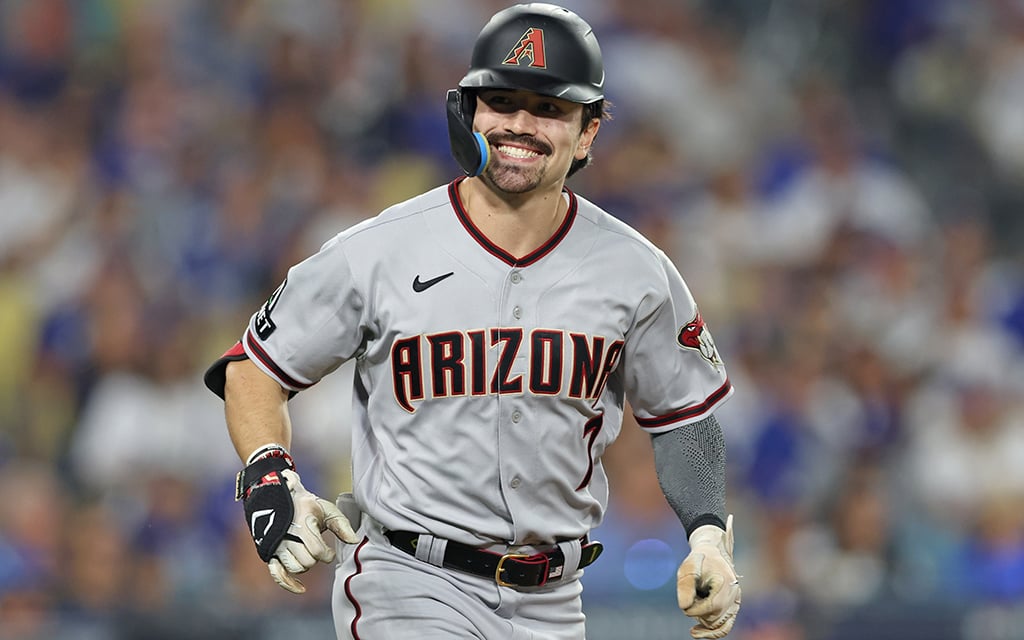
Simply winning the Rookie of the Year Award does not guarantee success beyond that first season in the Majors. Every player has the best season of their career, and for some it is that first season. There are others, who build upon their initial success. They finish their careers among the greatest ever. There are 19 players who won the Rookie of the Year Award and then had a Hall of Fame career:
- Jackie Robinson- Brooklyn Dodgers, 1947
- Willie Mays- New York Giants, 1951
- Frank Robinson- Cincinnati Reds, 1956
- Luis Aparicio- Chicago White Sox, 1956
- Orlando Cepeda- San Francisco Giants, 1958
- Willie McCovey- San Francisco Giants, 1959
- Billy Williams- Chicago Cubs, 1961
- Tony Oliva- Minnesota Twins, 1964
- Tom Seaver- New York Mets, 1967
- Rod Carew- Minnesota Twins, 1967
- Johnny Bench- Cincinnati Reds, 1968
- Carlton Fisk- Boston Red Sox, 1972
- Andre Dawson- Montreal Expos, 1977
- Eddie Murray- Baltimore Orioles, 1977
- Cal Ripken Jr.- Baltimore Orioles, 1982
- Jeff Bagwell- Houston Astros, 1991
- Mike Piazza- Los Angeles Dodgers, 1993
- Derek Jeter- New York Yankees, 1996
- Scott Rolen- Philadelphia Phillies, 1997
In addition to these 19 Hall of Famers, there are five more players who will join them in Cooperstown when they are eligible. There will certainly be more, but these five are all but guaranteed to be enshrined in the Hall of Fame.
- Albert Pujols- St. Louis Cardinals, 2001
- Ichiro Suzuki, Seattle Mariners, 2001
- Justin Verlander- Detroit Tigers, 2006
- Bryce Harper- Washington Nationals, 2012
- Mike Trout, Los Angeles Angels, 2012
The Rookie of the Year Award celebrates the best new talent in the Majors each season. The players selected each season are not guaranteed a long and successful career, nor are they doomed to mediocrity. One great season does not define a player, but it can gain them recognition. Teams are tasked with developing the players and their success is reflected in winning the Rookie of the Year Award. It is nearly impossible to win multiple seasons in a row, but a team should consistently produce good, young players. Occasionally one should win the award. The Dodgers have figured out how to do just that, and the Pirates have not. All 30 MLB teams have now had a Rookie of the Year winner. Who adds to their list next season?
DJ
United States of Baseball-Nebraska
Every June the College World Series descends upon Omaha. Some of the best players in the country compete to see which school has the best team. Many of these players have aspirations to play professionally, hopefully reaching the Majors in the near future. The state of Nebraska has sent 119 players to the Major Leagues. The best pitcher from the Cornhusker State is Grover Cleveland Alexander. His 119.02 career WAR is the third highest for any state or territory pitching leader. The greatest position player born in Nebraska is Wade Boggs. His 91.42 career WAR ranks 15th highest among state and territory leaders. Nebraska’s combined 210.44 WAR, ranking the state 10th in the United States of Baseball.
Grover Cleveland Alexander was born in Elba. He is the only baseball player named for a sitting American President, Grover Cleveland, and portrayed by a future one in film, Ronald Reagan. Growing up in rural Nebraska, Alexander developed strong forearms shucking corn, which later enabled him to throw a devastating curveball. Life and baseball were not always easy. He developed Epilepsy after taking a baseball to the face while breaking up a Double Play in 1909. Epilepsy was considered a curse of the devil, so Alexander actively hid his condition. After the Phillies bought him for $500 from Syracuse he pitched for 20 seasons in the Majors with three teams: Philadelphia Phillies (1911-1917, 1930), Chicago Cubs (1918-1926), and St. Louis Cardinals (1926-1929).

The Sidearm Pitcher burst into the Majors in 1911, finishing with a 28-13 record and 2.57 ERA. Alexander’s 28 Wins were the most by a rookie in the 20th century. In his career, Alexander pitched in 696 Games, made 600 Starts, threw 436 Complete Games, including 90 Shutouts, Pitched 5,190 Innings, allowed 4,868 Hits, 1,852 Runs, 1,476 Earned Runs, 165 Home Runs, 951 Walks, 2,198 Strikeouts, posted a 373-208 record, 2.56 ERA, 1.121 WHIP, and 135 ERA+. He won 20 games in nine seasons, five ERA titles in six years from 1915 to 1920, and the Pitching Triple Crown three times in the same span. Alexander is the only pitcher to win the Pitching Triple Crown with multiple teams. He was the 11th pitcher to reach 300 wins and helped the Cardinals win the 1926 World Series. Alexander’s baseball legacy was enshrined in the Hall of Fame in 1938.
The best season of Alexander’s career was with the 1915 Phillies. He pitched in 49 Games, made 42 Starts, threw 36 Complete Games, including 12 Shutouts, Pitched 376.1 Innings, allowed 253 Hits, 86 Runs, 51 Earned Runs, 3 Home Runs, 64 Walks, 241 Strikeouts, posted a 31-10 record, 1.22 ERA, 0.842 WHIP, and 225 ERA+. Alexander led the National League in Complete Games, Shutouts, Innings Pitched, Strikeouts, Wins, ERA, Winning Percentage, WHIP, and ERA+. He also threw four one hitters that season.
Alexander pitched in three World Series: 1915 with the Phillies and 1926 and 1928 with the Cardinals. He pitched in 7 Games, made 5 Starts, threw 4 Complete Games, Pitched 43 Innings, allowed 36 Hits, 18 Runs, 17 Earned Runs, 3 Home Runs, 12 Walks, 29 Strikeouts, posted a 3-2 record, 3.56 ERA, and 1.116 WHIP. His success in the Regular Season carried into the Fall Classic.
The war in Europe brought an end to Alexander’s time in Philadelphia. The Phillies, believing he would be drafted, sold him to the Cubs for $55,000. Philadelphia was right, Alexander soon changed uniforms again, trading baseball for the United States Army. He spent seven weeks on the front lines, from which he never fully recovered. Combat left Alexander deaf in his left ear, shrapnel in his right ear, muscle damage to his right forearm from firing his rifle, shell shock (PTSD), and he became an alcoholic trying to hide his epilepsy. Alexander returned to the mound with the scars of war, but Cubs Manager Joe McCarthy traded him to St. Louis for the waiver price due to his drinking. Cardinals manager Rogers Hornsby would handle Alexander’s drinking so long as he continued pitching well. Eventually his drinking overwhelmed his abilities. After a brief reunion with the Phillies Alexander retired. He finished with one more victory than Christy Mathewson, to whom he was often compared. However, researchers later found Mathewson’s win total was off by a single victory due to a mistake in the 1902 season. The correction meant Alexander and Mathewson, both masters of their craft and devastated from the horrors of World War I, finished their careers with 373 wins.
In retirement, Alexander continued struggling with alcoholism. He pitched briefly for the House of David, but was ineffective. He sought out coaching opportunities, but none materialized. He was divorced before reconciling with his wife. He was in and out of sanitariums. Alexander’s financial difficulties led baseball to establish a pension fund so the Hall of Famer did not live in poverty.
Superstitions are only crazy if they do not work. Eating chicken before every game worked for Wade Boggs. The Omaha native was drafted in the 7th Round of the 1976 MLB Draft, taking his many superstitions all the way to Cooperstown. Boggs played 18 seasons in the Majors with three teams: Boston Red Sox (1982-1992), New York Yankees (1993-1997), and Tampa Bay Devil Rays (1998-1999). He finished third for the 1982 American League in Rookie of the Year behind Cal Ripken Jr. Boggs was not a one season wonder. He played in 2,439 career Games, collected 3,010 Hits, 578 Doubles, 61 Triples, 118 Home Runs, 1,014 RBI, scored 1,513 Runs, 24 Stolen Bases, 1,412 Walks, 745 Strikeouts, .328 BA, .415 OBP, .443 SLG, .858 OPS, and 131 OPS+. He was a 12 time All Star. Boggs collected 200 Hits seven times, scored 100 Runs seven times, and Walked 100 times four times. He hit over .300 every season from 1982 to 1991. Boggs won two Gold Gloves at Third Base, five Batting Titles, and eight Silver Sluggers. He put the ball in play, never striking out more than 68 times in a season. Boggs’ final Home Run was also his 3,000th hit. Along the way he moved from the Red Sox to the Evil Empire, winning the 1996 World Series with the Yankees. In 2005, Boggs was elected to the Hall of Fame with 91.9% of the vote in his first year of eligibility.
The best season of Wade Boggs’ career is difficult to pin down. You could select any season from 1983 to 1988. His 240 Hits in 1985 were the most in a season since 1930. His best could be the 1987 season with Boston. He played in 147 Games, collected 200 Hits, 40 Doubles, 6 Triples, 24 Home Runs, 89 RBI, scored 108 Runs, 1 Stolen Base, 105 Walks, 48 Strikeouts, .363 BA, .461 OBP, .588 SLG, 1.049 OPS, and 174 OPS+. He set career highs in Home Runs and RBI, never coming close to equally his 24 long balls again. Boggs led the American League in Batting Average, On-Base Percentage, OPS, and OPS+. He won his third Silver Slugger and finished ninth for the MVP with a Red Sox team that finished six games below .500 and 20 games behind the Eastern Division champion Detroit Tigers.
Boggs played through the Curse of the Bambino, only to reach the top of the baseball world in the House That Ruth Built. He was playing Third when a grounder forever immortalized Bill Buckner. He was critical to his team’s success in October. In 39 Postseason Games, Boggs collected 42 Hits, 9 Doubles, 1 Triple, 2 Home Runs, 16 RBI, scored 15 Runs, 16 Walks, 20 Strikeouts, .273 BA, .337 OBP, .383 SLG, and .720 OPS.
There are six Nebraskans enshrined in Cooperstown: Grover Cleveland Alexander, Richie Ashburn, Wade Boggs, Sam Crawford, Bob Gibson, and Billy Southworth. Next week the United States of Baseball heads to the deserts of the Silver State. Nevada is next.
DJ
What Could Have Been
In 2008 the Tampa Bay Devil Rays dropped the Devil, becoming the Tampa Bay Rays. Changing their name also changed their fortunes. The Rays have a .535 winning percentage, much better than the Devil Rays, .399. Tampa is winning roughly 22 more games a season since the switch. In 12 seasons as the Rays, Tampa Bay has won at least 90 games seven times, made the Postseason five times, won the American League East twice, and reached one World Series. The Rays success has come while averaging 27th in team payroll.
Tropicana Field was not always home to success. The Devil Rays began play in 1998 and struggled through the 2007 season, their last as the Devil Rays. They averaged 25th in payroll, including ranking 10th in 2000. The 2004 season was the Devil Rays best, winning 70 games and did not finish last. Tampa Bay finished 4th, three games ahead of the Toronto Blue Jays.
Every expansion team has growing pains as they build a competitive team. Tampa Bay received no breaks in the Expansion Draft. None of their first five draft picks played more than three seasons in Tampa Bay. Teams need players to build around and the Devil Rays did not find a franchise player in the Expansion Draft.
The Devil Rays held the first overall pick in the 1997 Expansion Draft. Tampa Bay selected Florida Marlins pitcher Tony Saunders. In 1997, the 23 year old lefty started 21 games for the Florida Marlins, going 4-6 with a 4.61 ERA and 1.464 WHIP in 111.1 Innings, allowing 57 Earned Runs, 12 Home Runs, 64 Walks, and 102 Strikeouts. Saunders pitched in the Marlins Postseason run to their World Series victory. Saunders, a young lefty with Postseason experience, was a logical first pick.
The Devil Rays took Tony Saunders with the first overall pick in the 1997 Expansion Draft. (Jonathan Kirn/Allsport/ Getty Images)
The 1998 Tampa Bay Devil Rays struggled, finishing 63-99, 16 games behind the fourth place Baltimore Orioles. In 31 starts, Tony Saunders went 6-15 with a 4.12 ERA and 1.570 WHIP in 192.1 Innings, allowing 88 Earned Runs, 15 Home Runs, 111 Walks (league leader), and 172 Strikeouts. Saunders pitched 7+ innings in 10 starts, allowing 3 runs or less in nine of those starts. He won twice. In four of those starts, Saunders pitched 8 innings, allowing three runs or less, yet he lost all four starts. Saunders received 3.37 in run support, while Major League teams averaged 4.79 runs per game. Tony Saunders pitched well for the expansion Devil Rays, despite his record.
Tampa Bay and Tony Saunders entered the 1999 season full of hope. The Devil Rays sought to play more competitive baseball and Saunders looked to build upon his success. Entering play on May 26th, the Devil Rays were 22-24. An expansion team hovering around .500 a quarter of the way through the season had many hoping the Devil Rays would soon contend. The Texas Rangers were visiting Tropicana Field facing the surprising Devil Rays. In the Top of the Third Inning, the Rangers had runners on first and third with two outs, trailing 3-2. Tony Saunders had a full count on reigning American League MVP Juan Gonzalez. Saunders took the sign from John Flaherty and uncorked a Wild Pitch. Gonzalez trotted to first, Rusty Greer moved to second, and Luis Alicea scampered home to tie the game.
Tropicana Field fell silent except for Tony Saunders screaming, writhing in pain on the ground. The pitch broke the humerus bone, the bone connecting the shoulder and elbow, in Saunders’ left arm. Training staff tried helping Saunders up, but the pain was too much. He was carted off the field and taken to the hospital. His season was finished and his career was in doubt.
Professional baseball players are tough. They play through pain and injury throughout the long season. A year after breaking his arm Tony Saunders was pitching again. His rehab assignment began with the Charleston RiverDogs, Tampa Bay’s Single A team. Saunders pitched in two games, throwing 5 Innings, with a 1.80 ERA and 0.800 WHIP, allowing 2 Hits, 1 Earned Run, 2 Walks, and 3 Strikeouts. He was promoted to the St. Petersburg Devil Rays, Tampa Bay’s Advanced A team. Entering the Third Inning of his second game, Saunders had pitched 7 Innings with a 3.86 ERA and 1.429 WHIP, allowed 7 Hits, 3 Earned Runs, 3 Walks, and 3 Strikeouts. Then it happened again, Saunders broke his arm throwing a pitch. His Major League career was over.
Tony Saunders broke his arm throwing a baseball. The Devil Rays future rested on his left arm. (www.mlb.com)
The Devil Rays retained their rights to Saunders through 2004, when they released him. Less than a month later the Orioles signed Saunders. He pitched in Spring Training for the Orioles, but spent the 2005 season pitching for the Mesa Miners of the independent Golden Baseball League. He pitched 9 Games in relief, going 1-0 with a 1.80 ERA and 1.600 WHIP. He threw 10 Innings, allowed 9 Hits, 2 Earned Runs, 7 Walks, and 8 Strikeouts.
There are no guarantees in baseball. Tony Saunders is not alone in having his career cut short by injuries. However his injuries were particularly gruesome. The future of the Devil Rays rested on his left arm, it took years for Tampa Bay to recover. Tony Saunders’ efforts to continue his baseball career did not go unnoticed. He received the 2000 Tony Conigliaro Award from the Boston Chapter of the Baseball Writer’s Association of America. The annual award is given to a Major League player who best overcomes an obstacle and adversity through the attributes of spirit, determination, and courage. While the award cannot replace his career, it is important to recognize Saunders’ perseverance in his comeback attempts.
Tony Saunders’ final career statistics: 3 Seasons, 61 Games Started, 2 Complete Games, 13 Wins, 24 Losses, 4.56 ERA, 1.528 WHIP, 345.2 Innings Pitched, 343 Hits, 175 Earned Runs, 33 Home Runs, 204 Walks, and 304 Strikeouts.
Oh, what could have been in Tampa Bay.
DJ
Baseball Lifer
Don Zimmer will have his #66 retired by the Tampa Bay Rays in a pregame ceremonial before their home opener on April 6th. The Rays may not be the team most associated with Zimmer, but it was the organization that he spent the most time with, 11 seasons, during his 66 year career in baseball. Zimmer was a player, coach, or manager for nearly half of the teams in Major League Baseball. During his career he was a member of the Brooklyn/ Los Angeles Dodgers, Chicago Cubs, Cincinnati Reds, New York Mets, Washington Senators, San Diego Padres, Boston Red Sox, Texas Rangers, Montreal Expos, San Francisco Giants, Colorado Rockies, New York Yankees, and Tampa Bay Devil Rays/ Rays. Zimmer also spent a season (1966) playing for the Toei Flyers in Nippon Professional Baseball in Japan.
Zimmer was never an elite player. He hit a career .235, with 91 home runs, 352 RBI. He played more than 100 games only five times during his 12 year career, and was named an All Star in 1961. As a manager Zimmer collected 885 wins in 13 seasons at the helm with four different teams. He won 50.8% of the games he managed. He won his lone Division title with the 1989 Cubs, but lost to the Giants four games to one in the National League Championship Series.
None of the statistics which are associated with Don Zimmer should put him in elite company. However, his longevity and passion for the game do. Few, if anything written about Zimmer reflects negatively on the man. Yes, the local media and fans may have grown tired of his struggles on the field and as manager, but never of his desire to see his team win. Even the incident with Pedro Martinez in 2003 during the American League Championship Series should be seen as Zimmer sticking up for his team, even if his body was not up to the task his brain had in mind. He was sticking up for the Yankees, his guys. His apology afterwards can make a grown man cry, because you can sense the embarrassment he felt as he apologizes to everyone, before he leaves the press conference in tears.
Hopefully, over time this moment will no longer be what most people think of when they think of Don Zimmer. His broad smile and love of the game were on display everyday he put on a uniform. He never had to work a day in his life. Zimmer was the type of person who have propelled baseball through the generations. They allow for a real connection to exist between the past and present. Zimmer’s contribution to the game goes beyond the stat sheet, thus the honor the Rays are giving him in retiring his jersey number is a tribute not only to Zimmer, but also to the other baseball lifers. It is these individuals who, despite not making the world stop and take notice of their accomplishments, are immeasurably important to the game.
Several of the other teams which Zimmer played or worked for during his career could retire his number. The Red Sox, Cubs, and Yankees could have all justified retiring his number, but ultimately it is good that at least one team did retire his number. Regardless how important he was to any single organization, Don Zimmer was more important to the game of baseball. Zimmer spent his life around the game he loved; along the way the game loved him back. Now thanks to the Tampa Bay Rays, he will be loved far into the future even once the people he worked with in baseball are gone. Baseball has shown the epitome of a baseball life the love that the game as a whole can give a man after he spent a life time loving the game.
D
Expansion
Fittingly on the 20th anniversary of the Tampa Bay (Devil) Rays and Arizona Diamondbacks receiving approval to join Major League Baseball, The Winning Run is also expanding John has officially joined us in our devotion to the only real game. While John has been around since the beginning, he is now officially a member of the staff. In addition to assisting with social media, he will be a contributing writer (click here for his first article), and go on some amazing baseball adventures with Jesse and myself.
Please read his full biography below:
I am the third wheel to bullpen car (look it up) that is The Winning Run. I’ve tagged along and shared much time and conversation with the founders that I’ve been promoted to the bigs. I watch as much baseball as possible and read all I can during the season and the off season. I tend to be a Yankees fan on most occasions but love the game more than anything else. My claim to fame is being at the final game of Old Yankee Stadium with The Winning Run.
Welcome to The Winning Run John. Lets have some fun.
D


